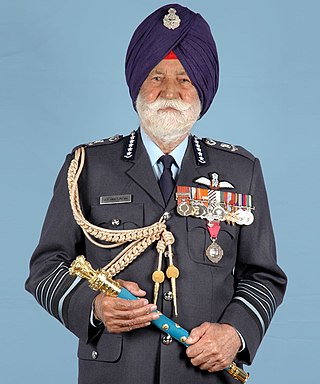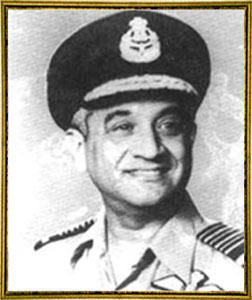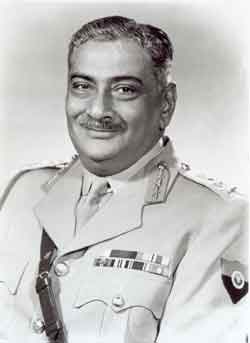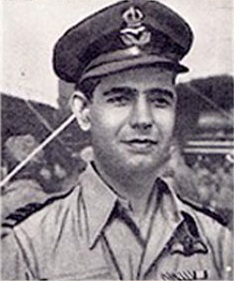Related Research Articles

Field Marshal Sir Claude John Eyre Auchinleck,, , was a British Indian Army commander who saw active service during the world wars. A career soldier who spent much of his military career in India, he rose to become commander-in-chief of the Indian Army by early 1941 during the Second World War. In July 1941 he was appointed commander-in-chief of the Middle East Theatre, but after initial successes, the war in North Africa turned against the British-led forces under his command, and he was relieved of the post in August 1942 during the North African campaign.

The former Royal Air Force Far East Air Force, more simply known as RAF Far East Air Force, was the Command organisation that controlled all Royal Air Force assets in the east of Asia. It was originally formed as Air Command, South East Asia in 1943 during the Second World War. In 1946, this was renamed RAF Air Command Far East, and finally Far East Air Force in June 1949.
Air marshal is an air-officer rank used by some air forces, with origins from the Royal Air Force. The rank is used by the air forces of many countries which have historical British influence, including many Commonwealth nations. The rank is usually equivalent to a vice admiral or a lieutenant general.
Air chief marshal is a high-ranking air officer rank used by some air forces, with origins from the Royal Air Force. The rank is used by air forces of many countries that have historical British influence. This rank is also equivalent to an Admiral in a navy or a full general in an army or other nations' air forces.

Field Marshal Sam Hormusji Framji Jamshedji Manekshaw, also known as Sam Bahadur, was the chief of the army staff of the Indian Army during the Indo-Pakistani War of 1971, and the first Indian Army officer to be promoted to the rank of field marshal. His active military career spanned four decades, beginning with service in World War II.

The Chief of the Army Staff (COAS) is a statutory office held by the professional head of the Indian Army (IA), the land forces branch of the Indian Armed Forces. Customarily held by a four-star general officer, the COAS is the senior-most operational officer of the IA, tasked with the roles of overseeing the overall functioning of the force during peace and wartime, committing to the preparation-cum-maintenance of the force's operational effectiveness and defending the nation's territorial integrity-cum-sovereignty. Also a permanent member of the Chiefs of Staff Committee (COSC) and the National Security Council (NSC), the COAS also bears the responsibility of advising the nation's civilian leadership i.e., the Government of India on all matters privy to the IA.

Marshal of the Indian Air Force Arjan Singh, was a senior air officer of the Indian Air Force. He served as the 3rd Chief of the Air Staff from 1964 to 1969, leading the Air Force through the Indo-Pakistani War of 1965. He was the first and only officer of the Indian Air Force (IAF) to be promoted to five-star rank as Marshal of the Indian Air Force, equal to the army rank of Field Marshal.

Air Chief Marshal Pratap Chandra Lal, DFC was the Chief of Air Staff (CAS) of the Indian Air Force (IAF) during the Indo-Pakistani War of 1971. He served in the IAF from 1939 until his retirement in 1973. He was the CAS at the time of Operation Chengiz Khan, the preemptive strikes that were carried out by the Pakistan Air Force (PAF) that marked the formal initiation of hostilities of the war.

Field Marshal Kodandera Madappa Cariappa, was an Indian military officer and diplomat who was the Indian Commander-in-Chief (C-in-C) of the Indian Army. He led Indian forces on the Western Front during the Indo-Pakistani War of 1947. He was appointed Commander-in-Chief of the Indian Army in 1949. He is one of only two Indian Army officers to hold the five-star rank of Field Marshal; the other being Field Marshal Sam Manekshaw.

Idris Hasan Latif, PVSM was a former air officer in the Indian Air Force. He served as the 10th Chief of Air Staff (CAS) of the Indian Air Force (IAF) from 1978 to 1981. After retiring from the air force, he served as 11th Governor of Maharashtra from 1982 to 1985.

General Kodendera Subayya Thimayya, DSO was the 3rd Chief of Army Staff from 1957 to 1961 during the crucial years leading up to the conflict with China in 1962. Thimayya was the only Indian to command an Infantry brigade in battle during the Second World War and is regarded as the most distinguished combat officer the Indian Army has produced. After the Korean War, Thimayya headed a United Nations unit dealing with the repatriation of prisoners of war. After his retirement from the Army, he was appointed Commander of the United Nations Peace Keeping Force in Cyprus from July 1964 to December 1965 and died in Cyprus while on active duty on 18 December 1965.

The Royal Indian Air Force (RIAF) was the aerial force of British India and later the Dominion of India. Along with the Indian Army, and Royal Indian Navy, it was one of the Armed Forces of British Indian Empire.

Air Marshal Subroto Mukerjee OBE was an Indian military officer who was the first Indian Commander-in-Chief (C-in-C) of the Indian Air Force. He was awarded several honours during the course of a three-decade-long career, ended by his untimely demise in 1960. He has been called the Father of the Indian Air Force.

The Chief of the Air Staff (CAS) is a statutory office held by the professional head of the Indian Air Force (IAF), the aerial branch of the Indian Armed Forces. Customarily held by a four-star air chief marshal, the CAS is the senior-most operational officer of the IAF, mandated with the responsibilities of supervising the force's overall functioning during states of peace and wartime, committing to the establishment-cum-continuity of air deterrence and executing India's security objectives vis-à-vis the preservation of the country's air sovereignty. Also a permanent member of the Chiefs of Staff Committee (COSC) and the National Security Council (NSC), the CAS also bears the responsibility of advising the nation's civilian leadership i.e., the Government of India on all matters privy to the IAF.

General Maharaj Shri Rajendrasinhji Jadeja, DSO, also known as K.S. Rajendrasinhji, was the first Chief of Army Staff of the Indian army, and the second Indian, after Field Marshal K. M. Cariappa, to become Commander-in-Chief of the Indian Army.

Air Marshal Aspy Merwan Engineer DFC was an officer in the Indian Air Force who rose through the ranks to become independent India's second Chief of the Air Staff, succeeding Subroto Mukerjee in 1960 and preceding Arjan Singh.

The Commander-in-Chief of the Pakistan Army was the professional head of the Pakistan Army from 1947 to 1972. The C-in-C was directly responsible for commanding the army. It was an administrative position and the appointment holder had main operational command authority over the army.

Air Chief Marshal Hrushikesh Moolgavkar, PVSM, MVC was a former Air officer in the Indian Air Force. He served as the 9th Chief of the Air Staff of the Indian Air Force from 1 February 1976 till 31 August 1978.
RAF India, later called Air Forces in India (1938–47) was a command of the Royal Air Force (RAF) that was active from 1918 until Indian independence and partition in 1947. It was the air force counterpart of the British Army in India.
Air Vice Marshal Erlic Wilmot Pinto, PVSM was an Air officer in the Indian Air Force. He was the Air Officer Commanding-in-Chief (AOC-in-C) Western Air Command when he was killed in the 1963 Poonch Indian Air Force helicopter crash. He served in the IAF from 1940 until his death in 1963. He was the theatre air commander commanding the air operations during the Annexation of Goa.
References
- 1 2 3 4 "Press Communique - 12 November 1947" (PDF). Press Information Bureau of India - Archive. 10 November 1947. Retrieved 19 July 2020.
- 1 2 "Press Communique - 12 November 1947 (Page 3)" (PDF). Press Information Bureau of India - Archive. 10 November 1947. Retrieved 19 July 2020.
- 1 2 3 4 5 "Press Report" (PDF). Press Information Bureau of India - Archive. 15 November 1947. Retrieved 19 July 2020.
- ↑ "Press Communique" (PDF). Press Information Bureau of India - Archive. 1 December 1947. Retrieved 19 July 2020.
- 1 2 3 "Press Note" (PDF). Press Information Bureau of India - Archive. 22 October 1947. Retrieved 19 July 2020.
- ↑ "Departure of Air Marshal H. S. P. Walmsley" (PDF). Press Information Bureau of India - Archive. 13 November 1947. Retrieved 19 July 2020.
- ↑ "Press Note" (PDF). Press Information Bureau of India - Archive. 1 August 1947. Retrieved 19 July 2020.
- ↑ "Last British Unit to Leave India on February 28 - Gen. Whistler's Address to Senior Officers" (PDF). Press Information Bureau of India - Archive. 18 February 1948. Retrieved 19 July 2020.
- Lake, A (1999). Flying units of the RAF. Shrewsbury, UK: Airlife. ISBN 1-84037-086-6.